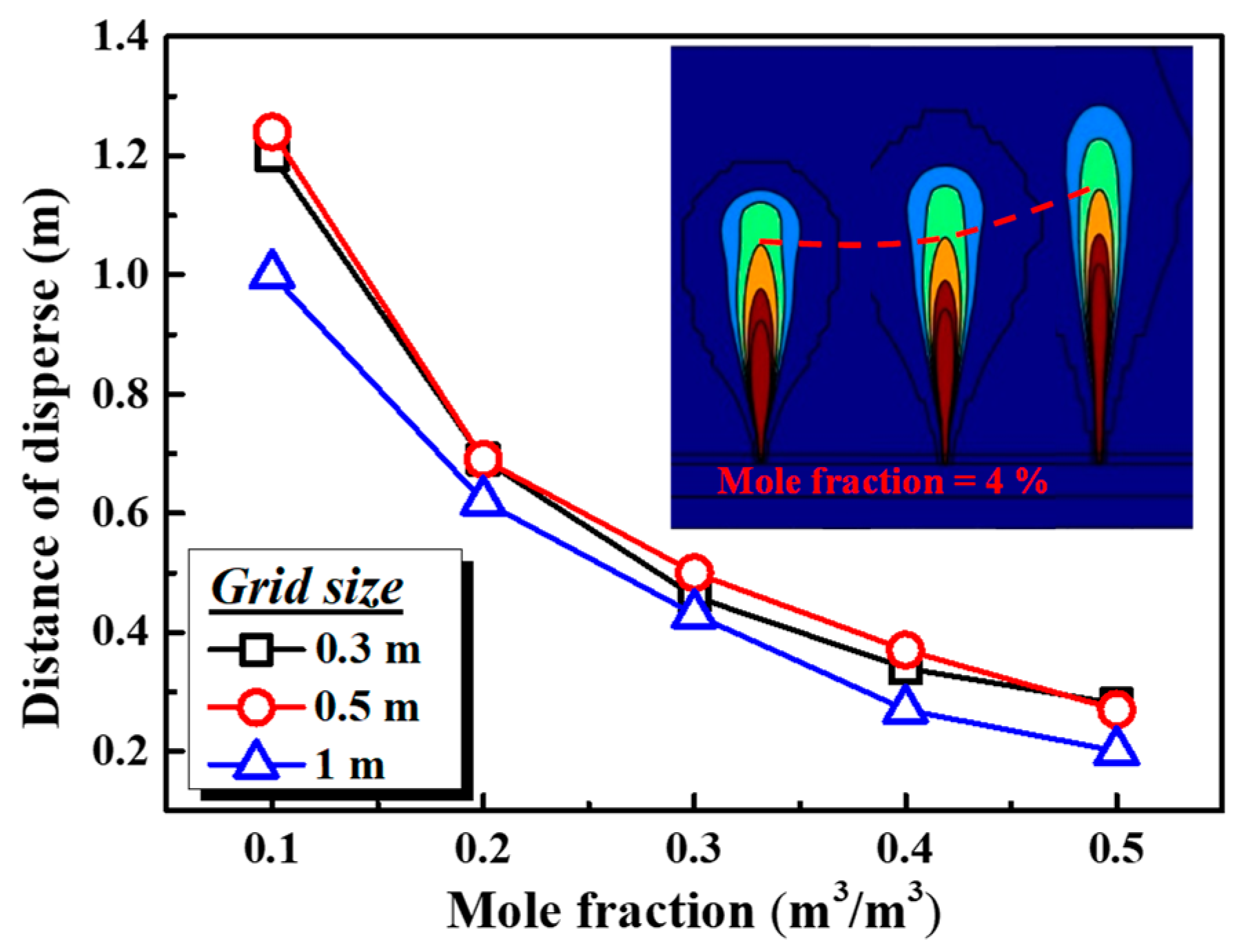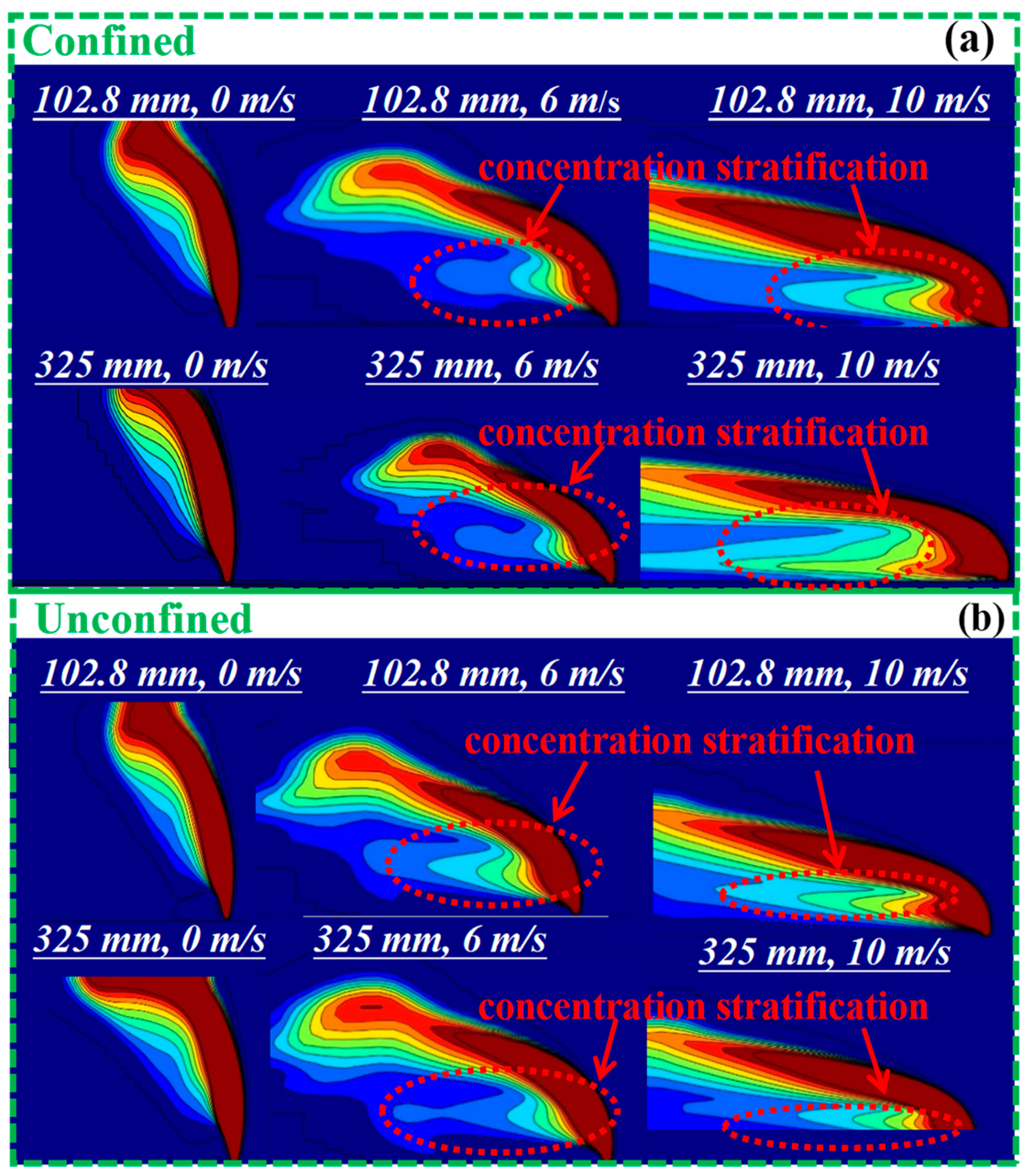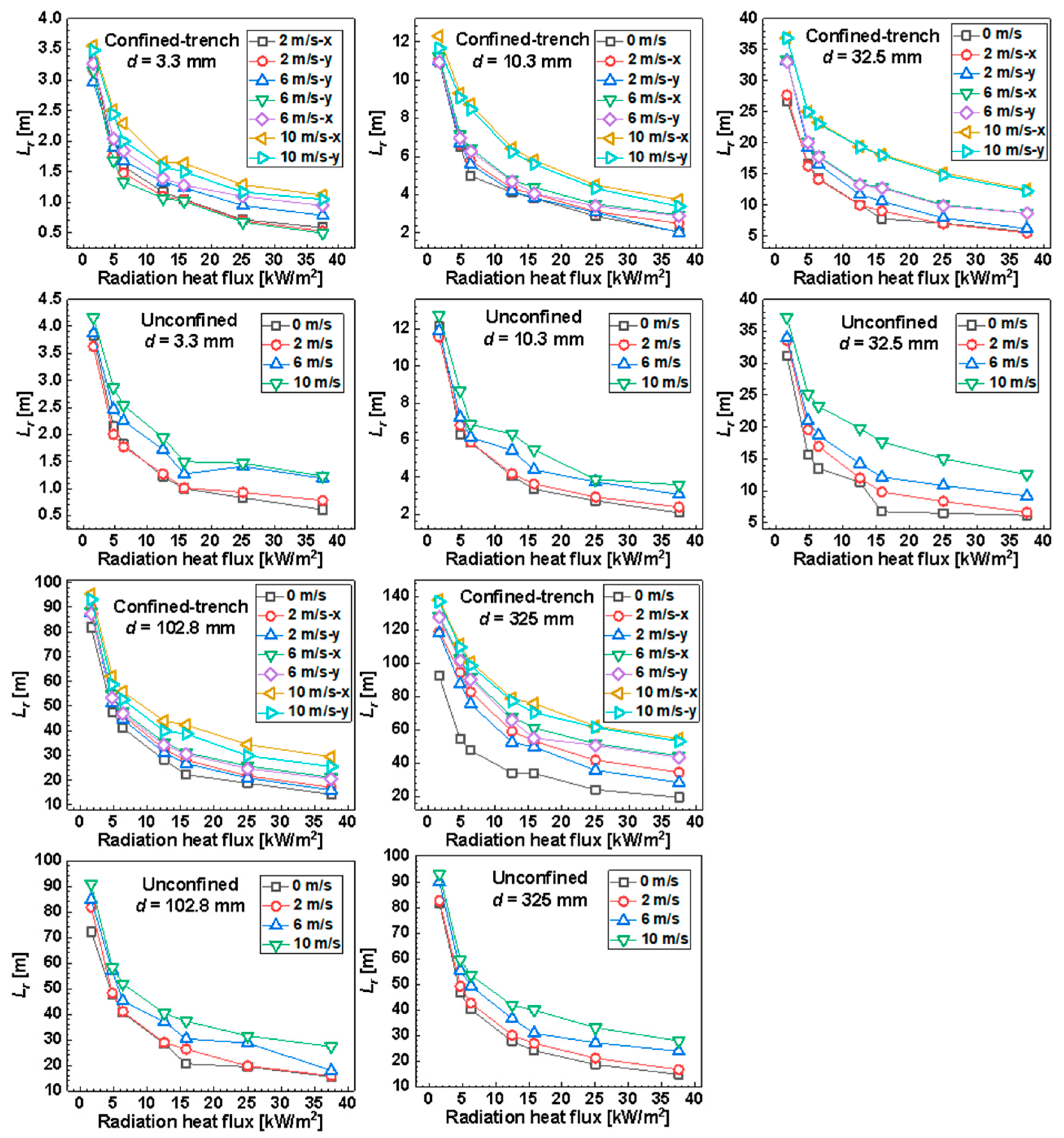Modeling of Hydrogen Dispersion, Jet Fires and Explosions Caused by Hydrogen Pipeline Leakage
Abstract
:1. Introduction
2. Numerical Approach
2.1. 3-D Models and Boundary Conditions
2.2. Grid Sensitivity Study and Steady Conditions
3. Results and Discussion
3.1. Hydrogen Gas Dispersion
- L increases significantly with leak hole size (d) due to the higher mass flow rates associated with larger leak holes.
- L moderately increases with wind speed (Uw). Higher wind speeds help gas cloud dilution but also bend the hydrogen plume toward the ground, increasing horizontal dispersion. Notably, when d = 3.3 mm and Uw = 0 m/s, L is the shortest at 0.17 m, equivalent to the hydrogen plume radius. The most hazardous scenario occurs at d = 325 mm and Uw = 10 m/s, resulting in the longest L at 110 m, serving as a conservative reference for hydrogen pipeline design.
- Under the same wind speed, L is the longest when the wind blows towards the longer side of the trench and is the shortest in unconfined cases. In trench scenarios, wind blowing towards the longer side results in a longer wind effect length, reducing wind dilution. Defining L as the ratio of the longest L and the shortest L of the same leak hole size under the same wind speed, the average value for L is 1.1, offering a valuable safety design reference. Notably, these ratios vary with the trench shape, a topic deserving future research.
- At relatively high wind speeds (6 m/s, 10 m/s), hydrogen attaches to the ground, causing concentration stratifications. The red circles in Figure 5 denote hydrogen concentration stratification. The Conada effect and fluid viscosity lead to ground attachment, particularly evident at high wind speeds, which enhance the Conada effect. This stratification poses safety risks due to potential ground-level ignition sources, including friction-induced static electricity and the tendency for flames to develop along the ground post-ignition. This phenomenon necessitates comprehensive exploration in future hydrogen pipeline leakage studies.
3.2. Jet Fire
- An increase in leak hole size leads to a greater jet flame thermal radiation distance (Lr). This is attributed to higher mass burning rates for hydrogen, as well as increased jet momentum and pure plume momentum under the assumption of stoichiometric combustion.
- Higher wind speeds result in an increase in Lr. Figure 7 illustrates four types of momentum contributing to the thermal plume: pure buoyancy momentum from the hydrogen plume (, where is the heat release rate (kW), is gravitational acceleration (m/s2), is the ambient density (kg/m3), is the specific heat of air at constant pressure (kJkg−1K−1), and is the ambient temperature (K)), thermal plume momentum from jet fire combustion (, where is the flame density (kg/m3)), jet momentum due to high-pressure leaks (, where is hydrogen density at the leak hole exit (kg/m3), is the hydrogen flow velocity at the leak hole exit (m/s), and is the leak hole diameter (m)), and wind momentum proportional to wind speed [28]. Winds not only bring hydrogen downward but also intensify turbulence and combustion. Higher wind momentum drives the thermal plume in the downwind direction, enhancing combustion and leading to an increase in Lr. For instance, when d = 325 mm, Uw = 10 m/s, and wind blows along the x-direction, Lr is the longest. Conversely, for d = 3.3 mm and Uw =0 m/s in an unconfined open space, Lr is the smallest. The radiation criterion of 15.8 kW/m2 is widely used to denote radiation hazard as the threshold causing 1% fatality and doing no harm to buildings [27]. In present cases, the greatest distance where radiation is 15.8 kW/m2 is 76 m, offering valuable guidelines for safety design.
- In confined trench spaces, Lr is greater when winds blow along the x-direction compared to the y-direction as a result of a larger area being directly influenced by the wind. Overall, for the same leak hole size and wind speed, Lr in unconfined open space is smaller than Lr in confined trench spaces. It is important to note that hydrogen dispersion distribution, crucial in determining jet fire thermal behaviors, also factors into wind speed and direction. The largest ratio of Lr in a confined trench space with wind along the x-direction to Lr in an unconfined open space is 2, serving as a conservative reference for hydrogen pipeline design.
3.3. Explosion
4. Conclusions
- Dispersion distances increase with leak hole size and wind speed. Moreover, the dispersion distance is greater under winds in the x-direction compared to the y-direction, and the dispersion distance in unconfined open spaces is the smallest. The maximum dispersion distance observed was 110 m. Additionally, hydrogen concentration stratifications occur under relatively high wind speeds due to the Conada effect.
- Jet flame thermal radiation distances, calculated using the DTM model, increase with leak hole size and wind speed. The radiation distance is the largest under winds in the x-direction and the smallest in unconfined open spaces. The longest radiation distance where the radiation is 15.8 kW/2 is 76 m.
- Explosion overpressures resulting from larger leak hole sizes in the present simulated pipelines are insufficient to cause damage. Leaks from smaller hole sizes, such as 10 mm or lower, pose minimal explosion hazards.
Author Contributions
Funding
Institutional Review Board Statement
Informed Consent Statement
Data Availability Statement
Acknowledgments
Conflicts of Interest
References
- Studer, E.; Jamois, D.; Jallais, S.; Leroy, G.; Hebrard, J.; Blanchetière, V. Properties of large-scale methane/hydrogen jet fires. Int. J. Hydrogen Energy 2009, 34, 9611–9619. [Google Scholar] [CrossRef]
- Lins, P.; Almeida, A. Multidimensional risk analysis of hydrogen pipelines. Int. J. Hydrogen Energy 2012, 37, 13545–13554. [Google Scholar] [CrossRef]
- Gao, Q.; Wang, L.; Peng, W.; Zhang, P.; Chen, S. Safety analysis of leakage in a nuclear hydrogen production system. Int. J. Hydrogen Energy 2022, 47, 4916–4931. [Google Scholar] [CrossRef]
- Liang, Y.; Pan, X.; Zhang, C.; Xie, B.; Liu, S. The simulation and analysis of leakage and explosion at a renewable hydrogen refueling station. Int. J. Hydrogen Energy 2019, 44, 22608–22619. [Google Scholar] [CrossRef]
- Birch, D.; Brown, R.; Dodson, G.; Swaffield, F. The Structure and Concentration Decay of High Pressure Jets of Natural Gas. Combust. Sci. Technol. 1984, 36, 249–261. [Google Scholar] [CrossRef]
- Wilkening, H.; Baraldi, D. CFD modelling of accidental hydrogen release from pipelines. Int. J. Hydrogen Energy 2007, 32, 2206–2215. [Google Scholar] [CrossRef]
- Birch, D.; Hughes, J.; Swaffield, F. Velocity Decay of High Pressure Jets. Combust. Sci. Technol. 1987, 52, 161–171. [Google Scholar] [CrossRef]
- Yu, X.; Wu, Y.; Zhao, Y.; Wang, C. Flame characteristics of under-expanded, cryogenic hydrogen jet fire. Combust. Flame 2022, 244, 112294. [Google Scholar] [CrossRef]
- Makarov, D.; Shentsov, V.; Kuznetsov, M.; Molkov, V. Pressure peaking phenomenon: Model validation against unignited re-lease and jet fire experiments. Int. J. Hydrogen Energy 2018, 43, 9454–9469. [Google Scholar] [CrossRef]
- Ekoto, W.; Houf, G.; Ruggles, J.; Creitz, W.; Li, X. Large-Scale Hydrogen Jet Flame Radiant Fraction Measurements and Modeling. In Proceedings of the 9th International Pipeline Conference, Calgary, AB, Canada, 24–28 September 2012. [Google Scholar]
- Houf, W.; Schefer, R. Predicting radiative heat fluxes and flammability envelopes from unintended releases of hydrogen. Int. J. Hydrogen Energy 2007, 32, 136–151. [Google Scholar] [CrossRef]
- Zhou, K.; Wang, X.; Liu, M.; Liu, J. A theoretical framework for calculating full-scale jet fires induced by high-pressure hydro-gen/natural gas transient leakage. Int. J. Hydrogen Energy 2018, 43, 22765–22775. [Google Scholar] [CrossRef]
- Ehrhart, B.; Hecht, E. Hydrogen Plus Other Alternative Fuels Risk Assessment Models (HyRAM+) Version 4.1 Technical Reference Manual; Sandia National Lab. (SNL-NM): Albuquerque, NM, USA, 2022. [Google Scholar]
- Lowesmith, B.; Mumby, C.; Hankinson, G.; Puttock, J.S. Vented confined explosions involving methane/hydrogen mixtures. Int. J. Hydrogen Energy 2011, 36, 2337–2343. [Google Scholar] [CrossRef]
- Froeling, H.; Drge, M.T.; Nane, G.; Wijk, A. Quantitative risk analysis of a hazardous jet fire event for hydrogen transport in natural gas transmission pipelines. Int. J. Hydrogen Energy 2021, 46, 10411–10422. [Google Scholar] [CrossRef]
- Jang, C.; Choi, S.; Baek, J. CFD modeling and fire damage analysis of jet fire on hydrogen pipeline in a pipe rack structure. Int. J. Hydrogen Energy 2015, 40, 15760–15772. [Google Scholar] [CrossRef]
- Dagdougui, H.; Garbolino, E.; Paladino, O.; Sacile, R. Hazard and risk evaluation in hydrogen pipelines. Manag. Environ. Qual. 2011, 21, 712–725. [Google Scholar] [CrossRef]
- Lutostansky, E.; Creitz, L.; Jung, S.; Schork, J.; Worthington, D.; Xu, Y. Modeling of underground hydrogen pipelines. Process Saf. Prog. 2013, 32, 212–216. [Google Scholar] [CrossRef]
- Lowesmith, J.; Hankinson, G. Large scale experiments to study fires following the rupture of high pressure pipelines conveying natural gas and natural gas/hydrogen mixtures. Process Saf. Environ. 2013, 91, 101–111. [Google Scholar] [CrossRef]
- Lowesmith, J.; Hankinson, G. Large scale high pressure jet fires involving natural gas and natural gas/hydrogen mixtures. Process Saf. Environ. 2012, 90, 108–120. [Google Scholar] [CrossRef]
- Russo, P.; De Marco, A.; Parisi, F. Assessment of the Damage from Hydrogen Pipeline Explosions on People and Buildings. Energies 2020, 13, 5051. [Google Scholar] [CrossRef]
- Groethe, M.; Merilo, E.; Colton, J.; Chiba, S.; Sato, Y.; Iwabuchi, H. Large-scale hydrogen deflagrations and detonations. Int. J. Hydrogen Energy 2007, 32, 2125–2133. [Google Scholar] [CrossRef]
- Lucas, M.; Atanga, G.; Hisken, H.; Mauri, L.; Skjold, T. Simulating vented hydrogen deflagrations: Improved modelling in the CFD tool FLACS-hydrogen. Int. J. Hydrogen Energy 2021, 46, 12464–12473. [Google Scholar] [CrossRef]
- Gexon AS. Flacs CFD Manual. 2020. Available online: https://www.gexcon.com/support/flacs-cfd/technical-manuals/ (accessed on 1 January 2022).
- Dasgotra, A.; Varun Teja, G.V.V.; Sharma, A.; Mishra, K.B. CFD modeling of large-scale flammable cloud dispersion using FLACS. J. Loss Prev. Process Ind. 2018, 56, 531–536. [Google Scholar] [CrossRef]
- EGPID Group. Gas Pipeline Incidents: 11th Report of the European Gas Pipeline Incident Data Group. 2020. Available online: https://www.egig.eu/reports (accessed on 1 January 2022).
- Stephens, M.; Leewis, K.; Moore, D. A Model for Sizing High Consequence Areas Associated with Natural Gas Pipelines. In Proceedings of the 4th International Pipeline Conference, Calgary, AB, Canada, 29 September–3 October 2002. [Google Scholar]
- Lin, Y.; Zhang, X.; Hu, L. An experimental study and analysis on maximum horizontal extents of buoyant turbulent diffusion flames subject to relative strong cross flows. Fuel 2018, 234, 508–515. [Google Scholar] [CrossRef]







| (kW/m2) | Damage to Equipment | Damage to Humans |
|---|---|---|
| 35 | Failure of operation of equipment | 1% fatality (10 s), 100% fatality (60 s) |
| 25 | The lowest energy for wood burning under radiation with no flame | Serious burn (10 s), 100% fatality (60 s), 1% fatality (10 s) |
| 12.5 | The lowest energy for wood burning under radiation with flame | 1% fatality (60 s), first degree burn (10 s) |
| 6.3 | No effect | Influencing escape route |
| 4.7 | No effect | Influencing safety zone |
| 1.58 | No effect | No effect |
Disclaimer/Publisher’s Note: The statements, opinions and data contained in all publications are solely those of the individual author(s) and contributor(s) and not of MDPI and/or the editor(s). MDPI and/or the editor(s) disclaim responsibility for any injury to people or property resulting from any ideas, methods, instructions or products referred to in the content. |
© 2023 by the authors. Licensee MDPI, Basel, Switzerland. This article is an open access article distributed under the terms and conditions of the Creative Commons Attribution (CC BY) license (https://creativecommons.org/licenses/by/4.0/).
Share and Cite
Lin, Y.; Ling, X.; Yu, A.; Liu, Y.; Liu, D.; Wang, Y.; Wu, Q.; Lu, Y. Modeling of Hydrogen Dispersion, Jet Fires and Explosions Caused by Hydrogen Pipeline Leakage. Fire 2024, 7, 8. https://doi.org/10.3390/fire7010008
Lin Y, Ling X, Yu A, Liu Y, Liu D, Wang Y, Wu Q, Lu Y. Modeling of Hydrogen Dispersion, Jet Fires and Explosions Caused by Hydrogen Pipeline Leakage. Fire. 2024; 7(1):8. https://doi.org/10.3390/fire7010008
Chicago/Turabian StyleLin, Yujie, Xiaodong Ling, Anfeng Yu, Yi Liu, Di Liu, Yazhen Wang, Qian Wu, and Yuan Lu. 2024. "Modeling of Hydrogen Dispersion, Jet Fires and Explosions Caused by Hydrogen Pipeline Leakage" Fire 7, no. 1: 8. https://doi.org/10.3390/fire7010008





